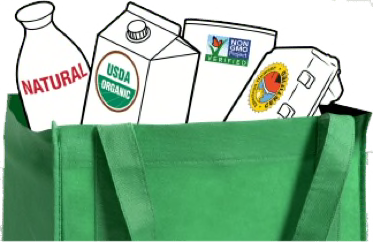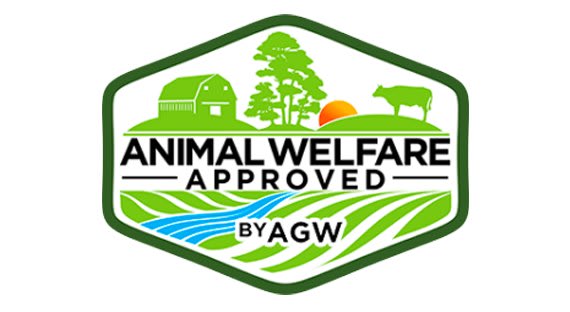Cattle are able to graze in a pasture their entire lives and are never housed in feedlots. (However, the beef is not 100 percent grass-fed unless it is also labeled Certified Grassfed by AGW.) They must have continuous access to housing or shelter to protect them from extreme weather. The standards allow surgical castration without pain relief on calves less than 2 months old but prohibit other painful procedures, such as dehorning and hot iron branding. Animals must be protected from temperature extremes during transport to the slaughterhouse and must be handled gently, without the use of electric prods.
Animals are raised on a pasture their entire lives, allowing for natural grazing behaviors. When housed, cows can't be confined in ways that restrict their movement. All animals have clean bedding, and ammonia levels (which come from animal waste and can harm animal and human health) in the building cannot be excessive. Tail docking isn't permitted.
Chickens are raised on a pasture, but also have to be protected from predators and extreme weather. The space requirements per bird exceed those of other animal welfare certification programs. Ventilation and natural light are required in chicken houses (if used). The standards prohibit the common practice of keeping the lights on nearly continuously in the chicken house. (That practice—which prevents the birds from sleeping so that they eat more, promoting faster growth—is a major animal welfare issue in chicken production.) There is also a limit on how quickly the chickens can grow. (A fast rate of growth causes health problems in chickens.) There are no federal humane slaughter standards for chickens, as there are for other animals, but the Animal Welfare Approved standards require gentle handling and proper stunning during the slaughter process.
Chickens are raised on a pasture but also have access to a chicken house. They must be protected from predators and have shelter to protect them from extreme weather. The space requirements per bird exceed those of other animal welfare certification programs. The standards also require perches, dust baths, and nest boxes, all of which are important for laying hens. Beak trimming is prohibited. (That practice, common on egg farms, is used to minimize damage from hens pecking each other. Hens often do this when they're housed in crowded conditions, with no ability to engage in their natural scratch-and-peck behaviors.)
The standards prohibit the confinement of breeder pigs (the female pigs that spend their lives in a cycle of pregnancy and nursing piglets) in narrow, barren crates—a major animal welfare concern in pork production. Breeder pigs must be housed in pens large enough to allow turning around, with materials such as straw to engage in their natural nesting behaviors. When the piglets are weaned, the "growing pigs" (those that will be slaughtered for meat when they reach market weight) are moved to group housing that provides bedding for each pig, with plenty of space that allows freedom of movement. (A 250-pound growing pig has a space of 22.5 square feet, more than what's required by other animal welfare organizations.) They also must have access to an outdoor area. Tail docking, a common practice on pig farms to prevent the problem of bored and closely confined pigs biting each other's tails, is not allowed. Animals must be protected from temperature extremes during transport to the slaughterhouse and must be handled gently, without the use of electric prods.
Farms and slaughterhouses are inspected annually, and in addition an inspector may visit a farm at any time unannounced.

Consumer Reports takes a detailed look at the requirements, definitions, standards, and verification procedures behind food labeling seals and claims, and distills this information into CR ratings. Our goal is to inform and empower consumers so they can act to create demand for a healthier, safer food system.


























